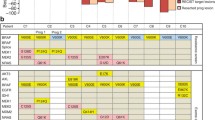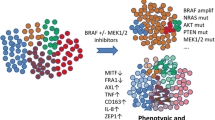Abstract
Purpose
The KIT inhibitor, imatinib, has shown promising efficacy in patients with KIT-mutated melanoma; however, acquisition of resistance to imatinib occurs rapidly in the majority of patients. The mechanisms of acquired resistance to imatinib in melanoma remain unclear.
Methods
We analyzed biopsy samples from paired baseline and post-treatment tumor lesions in one patient with KIT-mutated melanoma who had had an initial objective tumor regression in response to imatinib treatment followed by disease progression 8 months later.
Results
Targeted deep sequencing from post-treatment biopsy samples detected an additional mutation in CTNNB1 (S33C) with original KIT L576P mutation. We examined the functional role of the additional CTNNB1 S33C mutation in resistance to imatinib indirectly using the Ba/F3 cell model. Ba/F3 cell lines transfected with both the L576P KIT mutation and the CTNNB1 S33C mutation demonstrated no growth inhibition despite imatinib treatment, whereas growth inhibition was observed in the Ba/F3 cell line transfected with the L576 KIT mutation alone.
Conclusions
We report the first identification of the emergence of a CTNNB1 mutation that can confer acquired resistance to imatinib. Further investigation into the causes of acquired resistance to imatinib will be essential to improve the prognosis for patients with KIT-mutated melanoma.


Similar content being viewed by others
References
Wehrle-Haller B. The role of Kit-ligand in melanocyte development and epidermal homeostasis. Pigment Cell Res Spons Eur Soc Pigment Cell Res Int Pigment Cell Soc. 2003;16(3):287–96.
Duensing A, Medeiros F, McConarty B, Joseph NE, Panigrahy D, Singer S, et al. Mechanisms of oncogenic KIT signal transduction in primary gastrointestinal stromal tumors (GISTs). Oncogene. 2004;23(22):3999–4006. doi:10.1038/sj.onc.1207525.
Bauer S, Duensing A, Demetri GD, Fletcher JA. KIT oncogenic signaling mechanisms in imatinib-resistant gastrointestinal stromal tumor: PI3-kinase/AKT is a crucial survival pathway. Oncogene. 2007;26(54):7560–8. doi:10.1038/sj.onc.1210558.
Lux ML, Rubin BP, Biase TL, Chen CJ, Maclure T, Demetri G, et al. KIT extracellular and kinase domain mutations in gastrointestinal stromal tumors. Am J Pathol. 2000;156(3):791–5. doi:10.1016/s0002-9440(10)64946-2.
Rubin BP, Singer S, Tsao C, Duensing A, Lux ML, Ruiz R, et al. KIT activation is a ubiquitous feature of gastrointestinal stromal tumors. Can Res. 2001;61(22):8118–21.
Blanke CD, Demetri GD, von Mehren M, Heinrich MC, Eisenberg B, Fletcher JA, et al. Long-term results from a randomized phase II trial of standard- versus higher-dose imatinib mesylate for patients with unresectable or metastatic gastrointestinal stromal tumors expressing KIT. J Clin Oncol Off J Am Soc Clin Oncol. 2008;26(4):620–5. doi:10.1200/jco.2007.13.4403.
Beadling C, Jacobson-Dunlop E, Hodi FS, Le C, Warrick A, Patterson J, et al. KIT gene mutations and copy number in melanoma subtypes. Clin Cancer Res Off J Am Assoc Cancer Res. 2008;14(21):6821–8. doi:10.1158/1078-0432.ccr-08-0575.
Curtin JA, Busam K, Pinkel D, Bastian BC. Somatic activation of KIT in distinct subtypes of melanoma. J Clin Oncol Off J Am Soc Clin Oncol. 2006;24(26):4340–6. doi:10.1200/jco.2006.06.2984.
Carvajal RD, Antonescu CR, Wolchok JD, Chapman PB, Roman RA, Teitcher J, et al. KIT as a therapeutic target in metastatic melanoma. JAMA J Am Med Assoc. 2011;305(22):2327–34. doi:10.1001/jama.2011.746.
Guo J, Si L, Kong Y, Flaherty KT, Xu X, Zhu Y, et al. Phase II, open-label, single-arm trial of imatinib mesylate in patients with metastatic melanoma harboring c-Kit mutation or amplification. J Clin Oncol Off J Am Soc Clin Oncol. 2011;29(21):2904–9. doi:10.1200/jco.2010.33.9275.
Hodi FS, Corless CL, Giobbie-Hurder A, Fletcher JA, Zhu M, Marino-Enriquez A, et al. Imatinib for melanomas harboring mutationally activated or amplified KIT arising on mucosal, acral, and chronically sun-damaged skin. J Clin Oncol Off J Am Soc Clin Oncol. 2013;31(26):3182–90. doi:10.1200/jco.2012.47.7836.
Liegl B, Kepten I, Le C, Zhu M, Demetri GD, Heinrich MC, et al. Heterogeneity of kinase inhibitor resistance mechanisms in GIST. J Pathol. 2008;216(1):64–74. doi:10.1002/path.2382.
Todd JR, Scurr LL, Becker TM, Kefford RF, Rizos H. The MAPK pathway functions as a redundant survival signal that reinforces the PI3K cascade in c-Kit mutant melanoma. Oncogene. 2014;33(2):236–45. doi:10.1038/onc.2012.562.
Minor DR, Kashani-Sabet M, Garrido M, O’Day SJ, Hamid O, Bastian BC. Sunitinib therapy for melanoma patients with KIT mutations. Clin Cancer Res Off J Am Assoc Cancer Res. 2012;18(5):1457–63. doi:10.1158/1078-0432.ccr-11-1987.
Todd JR, Becker TM, Kefford RF, Rizos H. Secondary c-Kit mutations confer acquired resistance to RTK inhibitors in c-Kit mutant melanoma cells. Pigment Cell Melanoma Res. 2013;26(4):518–26. doi:10.1111/pcmr.12107.
Eisenhauer EA, Therasse P, Bogaerts J, Schwartz LH, Sargent D, Ford R, et al. New response evaluation criteria in solid tumours: revised RECIST guideline (version 1.1). Eur J Cancer (Oxford, England: 1990). 2009;45(2):228–47. doi:10.1016/j.ejca.2008.10.026.
Warmuth M, Kim S, Gu XJ, Xia G, Adrian F. Ba/F3 cells and their use in kinase drug discovery. Curr Opin Oncol. 2007;19(1):55–60. doi:10.1097/CCO.0b013e328011a25f.
Chien AJ, Moon RT. WNTS and WNT receptors as therapeutic tools and targets in human disease processes. Front Biosci J Virtual Libr. 2007;12:448–57.
Novellasdemunt L, Antas P, Li VS. Targeting Wnt signaling in colorectal cancer. A review in the theme: cell signaling: proteins, pathways and mechanisms. Am J Physiol Cell Physiol. 2015;309(8):C511–21. doi:10.1152/ajpcell.00117.2015.
Xue G, Romano E, Massi D, Mandala M. Wnt/beta-catenin signaling in melanoma: preclinical rationale and novel therapeutic insights. Cancer Treat Rev. 2016;49:1–12. doi:10.1016/j.ctrv.2016.06.009.
Uitdehaag JC, de Roos JA, van Doornmalen AM, Prinsen MB, Spijkers-Hagelstein JA, de Vetter JR, et al. Selective targeting of CTNBB1-, KRAS- or MYC-driven cell growth by combinations of existing drugs. PLoS One. 2015;10(5):e0125021. doi:10.1371/journal.pone.0125021.
Baldus SE, Monig SP, Huxel S, Landsberg S, Hanisch FG, Engelmann K, et al. MUC1 and nuclear beta-catenin are coexpressed at the invasion front of colorectal carcinomas and are both correlated with tumor prognosis. Clin Cancer Res Off J Am Assoc Cancer Res. 2004;10(8):2790–6.
Larue L, Kumasaka M, Goding CR. Beta-catenin in the melanocyte lineage. Pigment Cell Res Spons Eur Soc Pigment Cell Res Int Pigment Cell Soc. 2003;16(3):312–7.
Anastas JN, Moon RT. WNT signalling pathways as therapeutic targets in cancer. Nat Rev Cancer. 2013;13(1):11–26. doi:10.1038/nrc3419.
Chien AJ, Moore EC, Lonsdorf AS, Kulikauskas RM, Rothberg BG, Berger AJ, et al. Activated Wnt/beta-catenin signaling in melanoma is associated with decreased proliferation in patient tumors and a murine melanoma model. Proc Natl Acad Sci USA. 2009;106(4):1193–8. doi:10.1073/pnas.0811902106.
Delmas V, Beermann F, Martinozzi S, Carreira S, Ackermann J, Kumasaka M, et al. Beta-catenin induces immortalization of melanocytes by suppressing p16INK4a expression and cooperates with N-Ras in melanoma development. Genes Dev. 2007;21(22):2923–35. doi:10.1101/gad.450107.
Pacheco-Pinedo EC, Durham AC, Stewart KM, Goss AM, Lu MM, Demayo FJ, et al. Wnt/beta-catenin signaling accelerates mouse lung tumorigenesis by imposing an embryonic distal progenitor phenotype on lung epithelium. J Clin Investig. 2011;121(5):1935–45. doi:10.1172/jci44871.
Bulut G, Fallen S, Beauchamp EM, Drebing LE, Sun J, Berry DL, et al. Beta-catenin accelerates human papilloma virus type-16 mediated cervical carcinogenesis in transgenic mice. PLoS One. 2011;6(11):e27243. doi:10.1371/journal.pone.0027243.
Liu J, Ding X, Tang J, Cao Y, Hu P, Zhou F, et al. Enhancement of canonical Wnt/beta-catenin signaling activity by HCV core protein promotes cell growth of hepatocellular carcinoma cells. PLoS One. 2011;6(11):e27496. doi:10.1371/journal.pone.0027496.
Acknowledgements
This work was supported by a grant from the Korean Health Technology R&D Project, Ministry of Health & Welfare, Republic of Korea (HI14C3418).
Author information
Authors and Affiliations
Corresponding author
Ethics declarations
Conflict of interest
The authors declare that they have no conflict of interest.
Research involving human participants and/or animals
All procedures performed in studies involving human participants were in accordance with the ethical standards of the local ethics committee and with the 1964 Helsinki declaration and its later amendments or comparable ethical standards.
Informed consent statement
For our retrospective study, formal consent is not required.
Electronic supplementary material
Below is the link to the electronic supplementary material.
Rights and permissions
About this article
Cite this article
Cho, J., Kim, S.Y., Kim, Y.J. et al. Emergence of CTNNB1 mutation at acquired resistance to KIT inhibitor in metastatic melanoma. Clin Transl Oncol 19, 1247–1252 (2017). https://doi.org/10.1007/s12094-017-1662-x
Received:
Accepted:
Published:
Issue Date:
DOI: https://doi.org/10.1007/s12094-017-1662-x




